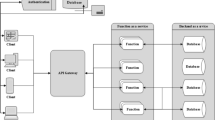Abstract
With regard to the failure and cancellation of business logic of web services composition (WSC), this paper propose a novel web services transaction compensation mechanism based on paired net which can dynamically establish agile compensation-triggered process (CSCP-Nets), and satisfy prospective compensation requirements. The related execution semantics of five usual composition compensation patterns based on paired net are analyzed in the situations of successful execution, failure compensation and failure recovery. Paired net based application of trip reservation process (TRP) shows that it is feasible.
Similar content being viewed by others
References
J. Gray. The transaction concept: Virtues and limitations. In Proceedings of the 7th International Conference on Very Large Data Bases, ACM, Cannes, France, pp. 144–154, 1981.
H. Garcia-Molina, K. Salem. Sagas. In Proceedings of the 1987 ACM SIGMOD International Conference on Management of Data, ACM, New York, USA, pp. 249–259, 1987.
A. K. Elmagarmid. Database Transaction Models for Advanced Applications, 1st ed., San Fransisco, USA: Morgan Kaufmann, 1992.
L. Bocchi, C. Laneve, G. Zavattaro. A calculus for longrunning transactions. In Proceedings of the 6th IFIP International Conference on Formal Methods for Open Objectbased Distributed Systems, Mendeley, Paris, France, pp. 124–138, 2003.
H. Foster, S. Uchitel, J. Magee, J. Kramer. Model-based verification of web service compositions. In Proceedings of the 18th IEEE International Conference on Automated Software Engineering, IEEE, Montreal, Canada, pp. 152–161, 2003.
X. Fu, T. Bultan, J. Su. Analysis of interacting BPEL web services. In Proceedings of the 13th International Conference on World Wide Web, ACM, New York, USA, pp. 621–630, 2004.
J. Cámara, C. Canal, J. Cubo, A. Vallecillo. Formalizing WSBPEL business processes using process algebra. Electronic Notes in Theoretical Computer Science, vol. 154, no. 1, pp. 159–173, 2006.
R. Lucchi, M. Mazzara. A pi-calculus based semantics for WS-BPEL. Journal of Logic and Algebraic Programming, vol. 70, no. 1, pp. 96–118, 2007.
S. Hinz, K. Schmidt, C. Stahl. Transforming BPEL to Petri nets. In Proceedings of the 3rd International Conference on Business Process Management, ACM, Nancy, France, pp. 220–235, 2005.
W. L. Dong, H. Yu, Y. B. Zhang. Testing BPEL-based web service composition using high-level Petri nets. In Proceedings of the 10th IEEE International Enterprise Distributed Object Computing Conference, IEEE, Hong Kong, China, pp. 441–444, 2006.
R. Bruni, H. Melgratti, U. Montanari. Theoretical foundations for compensations in flow composition languages. In Proceedings of SIGACT Symposium on Principles of Programming Languages, ACM, California, USA, pp. 209–220, 2005.
Z. Y. Qiu, S. L. Wang, G. G. Pu, X. P. Zhao. Semantics of BPEL4WS-like fault and compensation handling. In Proceedings of International Symposium of Formal Methods Europe, Springerlink, Newcastle, UK, pp. 350–365, 2005.
D. Biswas. Compensation in the world of web services composition. In Proceedings of the 1st International Workshop Semantic Web Services and Web Process Composition, Mendeley, San Diego, USA, pp. 69–80, 2005.
R. I. Hamed, S. I. Ahson, R. Parveen. Designing genetic regulatory networks using fuzzy Petri nets approach. International Journal of Automation and Computing, vol.7, no. 3, pp. 403–412, 2010.
Z. Zhang, D. D. Zhou, H. J. Yang, S. C. Zhong. A service composition approach based on sequence mining for migrating E-learning legacy system to SOA. International Journal of Automation and Computing, vol. 7, no. 4, pp. 584–595, 2010.
Y. K. Guo, L. Guo. IC cloud: Enabling compositional cloud. International Journal of Automation and Computing, vol.8, no. 3, pp. 269–279, 2011.
M. Vasko, S. Dustdar. An analysis of web services workflow patterns in Collaxa. In Proceedings of the 2004 European Conference on Web Services, Erfurt, Germany, pp. 1–14, 2004.
ActiveBPEL, [Online], Available: http://www.activebpel.org/download, March 30, 2012.
Author information
Authors and Affiliations
Corresponding author
Additional information
This work was supported by National High Technologies Research and Development Program of China (863 Program) (No. 2008BAH24B03), National Natural Science Foundation of China (Nos. 60673122 and 60940033), Postdoctoral Science Foundation of China (No. 20080440121), Natural Science Foundation of Hunan Province (Nos. 06017089 and 60940033), and Science and Technology Planning Project of Hunan Province (No. 2010GK3020).
Xiao-Yong Mei received his M. Sc. and Ph.D. degrees from Sun Yat-sen University, China in 2005 and 2011, respectively, and his B. Sc. degree from Hunan Normal University, China in 1997. Since 2005, He has been an associate professor at Hunan University of Arts and Science.
His research interests include serviceoriented computing and Petri-nets.
Yi-Yan Fan received the M. Sc. degree from Huazhong University of Science and Technology, China in 2005. Currently, he is a lecturer at Hunan University of Arts and Science, China.
His research interests include network security and service computing.
Chang-Qin Huang received M. Sc. degree from East China Normal University, China in 2001, and Ph.D. degree from Zhejiang University, China in 2005. Currently, he is a professor at South China Normal University, China.
His research interests include information technology and service computing.
Ai-Jun Jiang received her B. Sc. degree from Hunan University, China in 1992 and M. Sc. degree from Sun Yat-sen University, China in 1998. She is now a lecturer in Sun Yat-sen University. And she is also a Ph.D. candidate at Sun Yat-sen University currently.
Her research interests include serviceoriented computing and software testing.
Shi-Xian Li received his B. Sc. degree from Sun Yat-sen University in 1964. From 1983 to 1991, he was an associate professor at Sun Yat-sen University. Currently, he is a professor and Ph.D. supervisor in Sun Yat-sen University.
His research interests include software engineering and formal semantic.
Rights and permissions
About this article
Cite this article
Mei, XY., Fan, YY., Huang, CQ. et al. An aggregation composition compensation method based on paired net. Int. J. Autom. Comput. 9, 530–538 (2012). https://doi.org/10.1007/s11633-012-0676-7
Received:
Revised:
Published:
Issue Date:
DOI: https://doi.org/10.1007/s11633-012-0676-7




